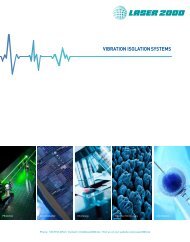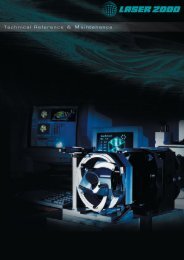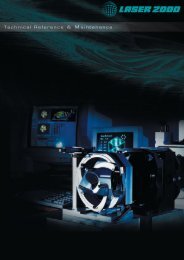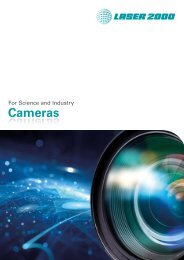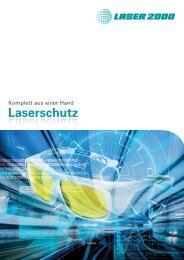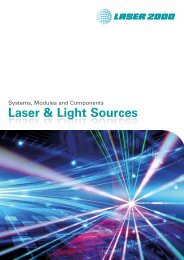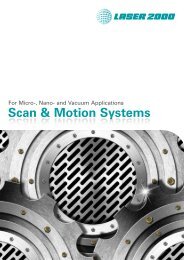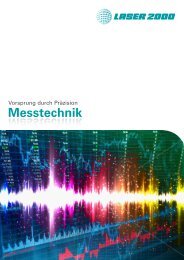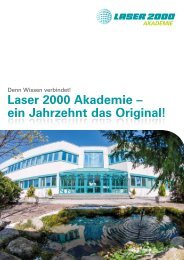Semrock Master Catalog 2018
Semrock Master Catalog 2018
Semrock Master Catalog 2018
You also want an ePaper? Increase the reach of your titles
YUMPU automatically turns print PDFs into web optimized ePapers that Google loves.
Fluorophores<br />
Single-band<br />
Sets<br />
Multiband<br />
Sets<br />
Cubes Laser<br />
Sets<br />
BrightLine ® Multiband Fluorescence Sets<br />
TECHNICAL NOTE<br />
Multiband Filter Set Configurations<br />
The ability to label multiple, distinct objects of interest in a<br />
single sample greatly enhances the power of fluorescence<br />
imaging. One way to achieve high-quality images of such<br />
samples has been to take multiple photographs while<br />
switching single-band filter cubes between photographs,<br />
and then later to combine these photographs<br />
electronically. Limitations to this approach historically<br />
included “pixel shift” among the multiple monochrome<br />
images, and the speed with which a complete multicolor<br />
image could be captured. <strong>Semrock</strong> solved the problem<br />
of “pixel shift” with its BrightLine ZERO technology,<br />
and the single-band filter cube approach remains the best<br />
technique for achieving images with the highest contrast<br />
and lowest bleedthrough possible. But with the increasing<br />
demand for high-speed imaging, especially for live-cell<br />
real-time analysis using fluorescent protein labels, there<br />
is a need for an alternative to the single-band filter cube<br />
approach that does not sacrifice too much image fidelity.<br />
<strong>Semrock</strong>’s advanced multiband optical filter technology<br />
brings simultaneous multicolor imaging to a new level.<br />
There are three types of multiband filter sets for<br />
simultaneous multicolor imaging. The “full multiband”<br />
configuration uses all multiband filters – exciter,<br />
emitter, and dichroic beamsplitter – and is ideal for<br />
“Full Multiband” Configuration<br />
(Multiband exciter, multiband emitter,<br />
& multiband dichroic)<br />
direct visualization, such as locating areas of interest on a<br />
sample. This approach is quick and easy to implement, and<br />
is compatible with all standard fluorescence microscopes.<br />
However, it requires a color camera for electronic imaging<br />
and cannot eliminate fluorophore bleedthrough. The<br />
“Pinkel” configuration uses single-band exciters in a filter<br />
wheel with multiband emitter and dichroic filters. It offers an<br />
economical way to achieve very high-speed, high-contrast,<br />
simultaneous multi-color imaging. This approach is based<br />
on a monochrome CCD camera, which is less expensive and<br />
offers better resolution and noise performance than color<br />
cameras. While bleedthrough is reduced relative to the fullmultiband<br />
approach, some bleedthrough is still possible<br />
since all emission bands are imaged simultaneously. The<br />
“Sedat” configuration uses single-band exciters and singleband<br />
emitters in synchronized filter wheels, with a multiband<br />
dichroic beamsplitter. This approach provides the best image<br />
fidelity for high-speed simultaneous multi-color imaging,<br />
though it requires a larger investment in system hardware.<br />
In fact, <strong>Semrock</strong> is your only source of “full multiband” quadband<br />
filter sets and the unique penta “Pinkel” and “Sedat” set.<br />
“Pinkel” Configuration<br />
(Multiband emitter, multiband<br />
dichroic, & single-band exciters)<br />
“Sedat” Configuration<br />
(Multiband dichroic, single-band exciters,<br />
& single-band emitters)<br />
NLO<br />
Filters<br />
Individual<br />
Filters<br />
Dichroic<br />
Beamsplitters<br />
“Full Multiband” Image<br />
Multi-color image captured with<br />
a color CCD camera<br />
“Pinkel” and “Sedat” Composite Image<br />
Single-color images are combined electronically to produce one<br />
high-fidelity, multi-color image<br />
Tunable<br />
Filters<br />
T-Cell and Antigen<br />
Presenting Cell (APC)<br />
conjugates demonstrating<br />
an immunologic synapse.<br />
Samples courtesy of<br />
Beth Graf and Dr. Jim Miller at the<br />
University of Rochester Medical Center<br />
More<br />
30



